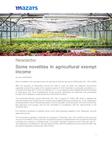
Some novelties in agricultural exempt income
With the issuance of Regulatory Decree No. 849 of June 16, 2020, the National Government regulated and set the scope of the exempt income for the Colombian countryside provided for in numeral 2 of Article 235-2 of the Tax Statute (E.T.). In such decree it was established that the Ministry of Agriculture and Rural Development would oversee identifying the agencies and procedures through which taxpayers could access the mentioned Incentive.
The mentioned Ministry issued Resolution No. 194 of August 14, 2020, with which it adopted the Instructive Manual to access the tax incentive and established the procedures for: (i) the registration and presentation of the investment projects in the countryside; (ii) the issuance of the act of conformity that approves such project; and (iii) the verification of compliance with the requirements in the following years.
It is therefore necessary to identify some of the most important aspects of the Resolution and the approved manual.
The first thing to highlight is that with the issuance of Resolution No. 194 of 2020 and its annexed manual, the limitation of the Exclusive Corporate Purpose is established for the companies that want to access the incentive, a limitation that, in principle, had been imposed in the Financing Law [1] -now declared unconstitutional- but that was overcome with the drafting of the Economic Growth Law [2] and the Regulatory Decree No. 849 of 2020.
The Instructive Manual reiterates the limitation to exclude from the corporate purpose of the beneficiary company any economic activity other than those set forth in Section A, Divisions 01, 02, 03 and/or Section C, Divisions 10 and 11 of the International Standard Industrial Classification - ISIC - leading to a certain limitation to the legal capacity of the company.
On the other hand, the Resolution provides that investment projects to increase rural productivity must be registered and submitted to the Directorates of: (i) Agricultural and Forestry, and (ii) Livestock, Fishing and Aquaculture Chains. The purpose of this is to verify compliance with regulatory requirements. Likewise, these Directorates will oversee verifying and following up the compliance with the commitments acquired by the beneficiary taxpayer. In addition, it is specified that, although the Directorates will oversee receiving the projects and reviewing their origin, the area in charge of issuing the acts of conformity and, therefore, granting the incentive will be the Vice-Ministry of Agricultural Affairs of the Ministry of Agriculture.
A third aspect to be highlighted is the obligation of the beneficiaries of the incentive to submit an annual report on the activities carried out during the execution of the investment project, an obligation that must be fulfilled before April 15 of each year. For this purpose, the Instructive Manual establishes the minimum content that such report must contain.
Another aspect to be mentioned is that the Instructive Manual establishes the scope and content of the investment project and the studies that comprise it: (i) socioeconomic, (ii) environmental, (iii) financial and (iv) technical, including the legal analysis and architectural design when applicable. Likewise, the virtual channels enabled for its presentation are also established. Therefore, taxpayers interested in benefiting from the tax incentive have the general framework for the structuring of their project.
In conclusion, the Instructive Manual and the Resolution that adopts it will allow taxpayers interested or linked to the Colombian countryside to benefit from the 10-year exempt income, since they already have clear parameters to aspire to such benefit.


